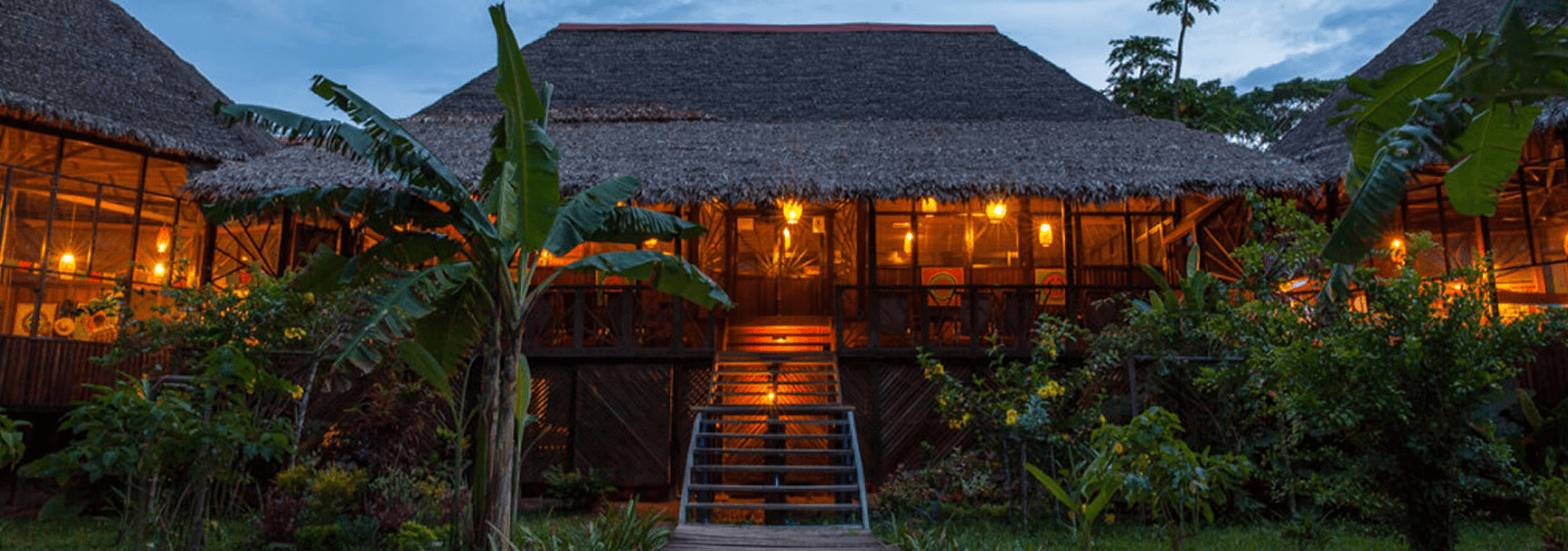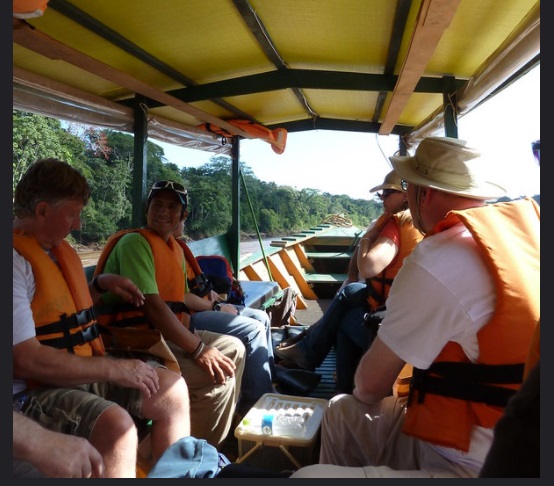In the Amazon department of Madre de Dios, the Tambopata National Reserve displays its richness in the form of colors, sounds, warmth and life.
Mammals, birds, reptiles and butterflies are shown without reservation; thousands of kinds of trees and flowers greet us as we pass; and aquatic creatures in their natural habitat play on our curiosity, sometimes posing for the camera. Tambopata in Perú is perfect to discover the jungle. And fall in love with her forever.
What can I see there?
The Tambopata National Reserve is huge, protecting 274,690 hectares (1,061 square miles) of pristine nature. To give you an idea of how big it is, it is roughly the size of the iconic Yosemite National Park in the United States. It contains a great diversity of habitats, from the old-growth Amazon rainforest to bamboo forests, from floodplains and wetlands to horseshoe lake and palm swamps.
Thanks to this variety of well-preserved habitats, Tambopata is one of the most biodiverse areas in the world. There are more than 1,000 species of butterflies, 100 species of mammals, 600 species of birds, and hundreds of species of trees and plants. During your visit, you are likely to see monkeys, parrots and macaws, alligators, toucans, and much more.
Who live in Tambopata Perú?

Lodge – Tambopata 
Tambopata
Tambopata in Perú is home to the Ese Eja Native Community, an indigenous nation that has lived in the rainforest region for many years. “That Eja” literally means people. There are three native communities of Ese Eja around the Tambopata National Reserve: Infierno (about 200 families), Palma Real (about 50 families) and Sonene (about 20 families).
Rainforest Expeditions has collaborated with the Ese Eja community in Infierno for over two decades, working together on nature and heritage preservation projects, and jointly directing the Posada Amazonas lodge.
Traditionally, the Ese Eja are hunters, fishermen and farmers, although many families now also have commercial or tourist connections. Today, tourism and chestnut gathering (a type of sustainable food production) are the two main economic activities within the Tambopata National Reserve.
In the areas surrounding the reserve, it is more common to grow tropical foods such as papaya, pineapple and cocoa. While tourism has grown in Tambopata in recent years, the region and reserve are so large that it is never crowded, providing an intimate, deeply wild experience.
Tambopata in Perú is now one of the main tourist destinations in Peru. If you like or love nature then Tambopata in Perú is for you.
How to get to Tambopata in Perú?
To get to the Tambopata National Reserve, you must first go to Puerto Maldonado. Puerto Maldonado is the entrance to the reserve and the capital of Madre de Dios. There are daily flights to Puerto Maldonado. These flights arrive from Lima or Cuzco, at least three times a day.
Flights from Lima depart from the domestic flights terminal at Jorge Chávez airport. The trip takes about 3 hours and most flights stop in Cuzco before continuing to Puerto Maldonado. Flights from Cusco depart from the national terminal of Velasco Astete airport, and the trip lasts around 45 minutes.
When to travel to Tambopata National Reserve?
Tambopata is slightly seasonal. Although it can rain at any time of the year, it is driest from April to November, when the rains stop and start, respectively. The rainiest months are January and February, but even then it rarely rains.
The advantages of visiting in the dry season are that there is very little chance that your activities will be affected by the rain.
The advantages of visiting in the rainy season is that the macaws are most active in the clay beds and are nesting. If you like macaws, come between December and February when nesting season is in full swing.
Tourist Routes
The most visited tourist destination is Lake Sandoval, located in the Madre de Dios river basin. This 127-hectare body of water is surrounded by palm trees full of macaws and is only half an hour by river from Puerto Maldonado. In its waters, which can be traveled in tour boats rented by local people and shelters, there is a large family of river wolves that can be seen hunting and preening on the logs. There is also an observatory tower for a panoramic view.
In the Tambopata river basin, upstream, there are other important lakes, such as Cocococha, 2 hours from Puerto Maldonado and also with the presence of river wolves; and Sachavacayoc, located 3 hours from Puerto Maldonado where there is a camping area to spend the night. Book the Amazon Expedition 4 Days.
Crossing the Tambopata river is the El Gato creek with its waterfall. Very close to there are the Baltimorillo rapids. The characteristic attractions of Tambopata are the clay licks that are found on the banks of the rivers, gathering hundreds of birds (macaws, hawks and parrots) offering a spectacular show of color and sound (all this especially between 5:30 and 9: 00 am).
Mammals such as sajinos, huanganas and sachavacas come to the mountain or inland clay licks, generally at night. The Chuncho and Colorado clay licks are located on the left bank of the Tambopata River. The latter is considered the largest known clay lick in the entire Peruvian Amazon. Within the Tambopata National Reserve , various places with various clay licks and various beaches have been identified where you can also see alligators, sachavacas, ronsocos and other species.
What to do?
The Tambopata National Reserve has an interpretation center on the way to Lake Sandoval and 8 checkpoints. In Lake Cocococha there is a hideout-viewpoint, camping areas in the Chuncho and Colorado clay licks, a camping area and jetty in Lake Sachavacayoc, an observation tower and jetty in Lake Sandoval, and piers in the Condenado lakes and in the La Torre checkpoint.
There are also private companies that provide accommodation within the protected area, which guarantees that the stay in this imposing corner of the country is pleasant and that it can be used to the maximum.
Tambopata River
The source of the Tambopata River has its origin in the Amazonian mountains, to flow into the Madre de Dios River in the Puno region, at an altitude of 180 meters.
On its way from the Peruvian Altiplano, it joins the Beni River, the Madeira River, the Amazon River, to finally empty what remains of its waters into the Atlantic Oceans.
Weather
The Tambopata River has a humid climate, characteristic of subtropical forests, whose average temperature reaches 26 ° C, with fluctuations between 10 ° C and 38 ° C. This occurs during the months of June to July, due to the strong winds that come from the Atlantic Ocean.
The Tambopata River during its journey, passes through the jungle ecosystem of the Amazon, maintaining characteristics typical of the rivers belonging to that region, with rapids, waterfalls and crystal clear waters, especially in times of intense rains when its basins are filled.
Flora and fauna
On its banks are the indigenous ethnic groups that are dedicated to agriculture and livestock. The Tambopata River brings with it a great variety of plant species¸ from its jungles and forests, coconut plants, chonta, mango, bananas, orchids, liana, bromelia, tubers, seeds and wild fruits, for its food.
In the Tambopata River you can see a fauna with abundant fish (pacú, payaras, zungaros, motas, chambiras, maidens), insects and a great variety of birds, especially parrots and macaws, whose song and color give joy to the banks of the river. There you can also see animals such as tigrillo, deer, monkeys of various species, alligators, snakes, armadillos, capybaras, big bears, herons, kingfishers, alligators and otters.
Tambopata Research Center
The Tambopata Research Center is the only lodge located within the Tambopata National Reserve, which makes it one of the most remote lodges in South America! The pristine location of the lodge means that it is surrounded by the best wildlife the Amazon rainforest has to offer.
Services in Tambopata Research Center
While resting after a day full of wildlife adventures, you can enjoy the many relaxing amenities we offer at the lodge. Take a nap in a comfortable hammock or get a jungle-inspired massage for true R&R. Lovers of artisan products can explore our exclusive boutique of local crafts, while curious tipplers can sample rainforest-inspired cocktails and classics like Pisco Sour at our lodge bar.
How to get to Tambopata Research Center?
To begin your rainforest tour, take a quick plane ride from Lima or Cuzco to the Amazon city of Puerto Maldonado in southeastern Peru. After we meet at the airport, we will take you on a one-hour road trip, followed by a leisurely two-and-a-half hour ride on the Tambopata River, to reach the Tambopata Research Center, our most isolated lodge.










